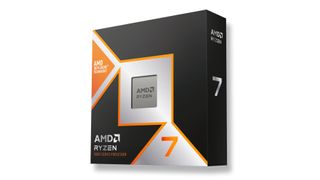AMD has officially announced its Ryzen 7 9800X3D processor, one of the worst-kept ‘secrets’ in the tech world this year (alongside Apple’s just-revealed M4 Macs).
The Ryzen 9800X3D is pretty much just as the avalanche of rumors suggested, with AMD confirming that as seen with previous spilled specs, it has 8 cores (16 threads) and a 4.7GHz base clock speed with a 5.2GHz max boost frequency. A rumor broke earlier today that the price would be $479 in the US, and this is now confirmed, too – a $30 hike on the MSRP of the 7800X3D.
Again, as leaked, this is an unlocked chip, so it can be overclocked. AMD explains that the Ryzen 9800X3D is ‘2nd-gen’ 3D V-Cache (as was rumored before), with the cache underneath the CCD (the die containing the cores) this time.
What this means is that the cores are now closer to the cooling solution, and therefore will be kept cooler – allowing for faster clock speeds compared to last-gen X3D.
The upshot is that AMD claims the Ryzen 9800X3D is 8% faster than the 7800X3D for gaming frame rates, as an average from testing across a large suite of some 40+ popular PC games (with a 7900 XTX GPU).
There are going to be some bigger boosts witnessed, and some games will witness double-digit gains (Star Wars Outlaws is singled out as one). AMD also claims the Ryzen 9800X3D is ‘up to an average’ of 20% faster than a system powered by Intel’s new flagship, the Intel Core Ultra 9 285K.
The Ryzen 9800X3D has a TDP of 120W and a total of 104MB cache, of which 64MB is the 3D V-Cache.
{ window.reliablePageLoad.then(() => { var componentContainer = document.querySelector(“#slice-container-newsletterForm-articleInbodyContent-wpjMD9uYDLthUojV2KuCa7”); if (componentContainer) { var data = {“layout”:”inbodyContent”,”header”:”Get the best Black Friday deals direct to your inbox, plus news, reviews, and more.”,”tagline”:”Sign up to be the first to know about unmissable Black Friday deals on top tech, plus get all your favorite TechRadar content.”,”formFooterText”:”By submitting your information you agree to the Terms & Conditions and Privacy Policy and are aged 16 or over.”,”successMessage”:{“body”:”Thank you for signing up. You will receive a confirmation email shortly.”},”failureMessage”:”There was a problem. Please refresh the page and try again.”,”method”:”POST”,”inputs”:[{“type”:”hidden”,”name”:”NAME”},{“type”:”email”,”name”:”MAIL”,”placeholder”:”Your Email Address”,”required”:true},{“type”:”hidden”,”name”:”NEWSLETTER_CODE”,”value”:”XTR-D”},{“type”:”hidden”,”name”:”LANG”,”value”:”EN”},{“type”:”hidden”,”name”:”SOURCE”,”value”:”60″},{“type”:”hidden”,”name”:”COUNTRY”},{“type”:”checkbox”,”name”:”CONTACT_OTHER_BRANDS”,”label”:{“text”:”Contact me with news and offers from other Future brands”}},{“type”:”checkbox”,”name”:”CONTACT_PARTNERS”,”label”:{“text”:”Receive email from us on behalf of our trusted partners or sponsors”}},{“type”:”submit”,”value”:”Sign me up”,”required”:true}],”endpoint”:”https://newsletter-subscribe.futureplc.com/v2/submission/submit”,”analytics”:[{“analyticsType”:”widgetViewed”}],”ariaLabels”:{}}; var triggerHydrate = function() { window.sliceComponents.newsletterForm.hydrate(data, componentContainer); } if (window.lazyObserveElement) { window.lazyObserveElement(componentContainer, triggerHydrate); } else { triggerHydrate(); } } }).catch(err => console.error(‘%c FTE ‘,’background: #9306F9; color: #ffffff’,’Hydration Script has failed for newsletterForm-articleInbodyContent-wpjMD9uYDLthUojV2KuCa7 Slice’, err)); }).catch(err => console.error(‘%c FTE ‘,’background: #9306F9; color: #ffffff’,’Externals script failed to load’, err)); ]]>
Sign up to be the first to know about unmissable Black Friday deals on top tech, plus get all your favorite TechRadar content.

(Image credit: AMD)
Analysis: Don’t forget about the higher lows
Everything is pretty much as expected, then, including that 8% generational gain for PC gaming frame rates that was previously leaked – and disappointed some folks. Perhaps that’s why AMD has qualified this press release quite considerably around the topic of gen-on-gen improvements – the figure is just an average, and some titles (in certain scenarios) will doubtless do quite a bit better than this. Although we don’t get a hint as to what some of the bigger uplifts might be.
What we do get is a clear comparison to the Arrow Lake flagship, albeit with some odd wording – what is ‘up to an average’ of 20%? Does it just mean the average is 20%? But if so, why stick ‘up to’ in there – it’s either ‘up to’ a top-end figure, or it’s an average, full-stop, surely? Or does it mean that it’s 20% if you pick a selection of certain games, but not all of them (AMD tested a bunch in that comparison)?
We don’t know, but given Arrow Lake has stumbled when it comes to gaming, we’d expect a favorable comparison for the new Ryzen 9800X3D anyway.
Notably, as part of building a case for the strength of the Ryzen 9800X3D, AMD highlights the chip’s generational improvement in terms of minimum frame rates. An example given is The Last Of Us: Part 1, where Team Red says the 9800X3D has a “similar average frame rate to the competition” (the Intel Core i9-14900K) but it is 31% higher when it comes to 1% low frame rates. What that means is that the Ryzen CPU delivers a more consistent smoothness, with fewer drops (or judders) to very low frame rates – and that’s definitely a good thing.
As ever, though, we need some independent testing to be sure that these claims pan out just as AMD has asserted in this press release. The Ryzen 9800X3D is set to go on sale come November 7, in a week’s time, at $479 as noted – and there will be some disappointment at the increase in MSRP gen-on-gen.
Still, it’s not a huge hike by any means – but some may be grinding their teeth that they didn’t pick up the 7800X3D when it was available for not much more than $300 on sale a few months back. We’ll just have to see how the Ryzen 9800X3D fares when we put the chip through its paces ourselves – and how much better the CPU might be than its predecessor in our benchmarks. Stay tuned.

